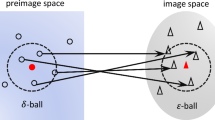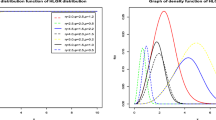Abstract
In this paper, we present the results of applying the model of cyclic point processes with a limited aftereffect for the analysis of the rhythmic characteristics of pulsed signals. Being a generalization of recurrent and alternating point processes, we show that cyclic processes can describe event flows with more than two states. The latter circumstance significantly expands the scope of their application, in particular, to biomedical signals. Here, a complete (local) statistical description of the cyclic processes is derived, the asymptotics of their behavior are studied, and a simplified statistical description for the case of stationary modes is given. In the latter case, analytical expressions for the average and second mixed moments of the cyclic process are obtained based on the local statistics. In the most important particular case, the dependence of the features of their structure on the time scales of the signal dynamics and on the ratios between the scales was clarified.



Similar content being viewed by others
Notes
For more information on terminology in this field, see the note in [3, p. 100].
REFERENCES
A. Napolitano, Cyclostationary Processes and Time Series. Theory, Applications, and Generalizations (Elsevier, 2019).
A. Ya. Khinchin, Tr. MIAN SSSR 49, 3 (1955).
I. A. Bol’shakov, Statistical Problems of Signal Flow Extraction from Noise (Sovetskoe Radio, Moscow, 1969) [in Russian].
D. R. Cox and H. D. Miller, The Theory of Stochastic Processes (Methuen & Co LTD, London, 1970).
R. Barbieri, E. C. Matten, A. A. Alabi, and E. N. Brown, Am. J. Physiol. Heart Cicr. Physiol. 288 (1), H424 (2005).
R. Serfozo, Basics of Applied Stochastic Processes (Springer-Verlag, Berlin, 2009).
V. E. Antsiperov, Zh. Radioelektron., No. 6 (2015). http://jre.cplire.ru/jre/jun15/8/text.pdf.
V. E. Antsiperov, in Physics—Life Sciences (Theses 2nd Russian Conf. with Int. Participation, St.-Petersburg, Sept. 18–22,2017) (Ioffe FTI, St.-Petersburg, 2017), p. 61.
V. E. Antsiperov, in Radiolocation and Radio Communication (Proc. 11th All-Russian Conf., Moscow, Nov. 27–29,2017) (IRE, Moscow, 2017), p. 359.
V. Antsiperov, Biomed. Radioelektronika 7, 61 (2018).
V. E. Antsiperov, Fiz. Osn. Priborostr. 7 (4), 70 (2018). https://doi.org/10.25210/jfop?1804-070077
V. I. Tikhonov and M. A. Mironov, Markovian Processes (Sovetskoe Radio, Moscow, 1977) [in Russian].
S. M. Rytov, Introduction to Statistical Radiophysics, Part 1: Random Proceses (Nauka, Moscow, 1976), [in Russian].
H. Bateman and A. Erdélyi, Higher Transcendental Functions (R. E. Krieger Pub. Co., Malabar, Fla., 1981; Nauka, Moscow, 1974), Vol. 2.
H. Bateman and A. Erdélyi, Tables of Integral Transforms (McGraw-Hill, New York, 1954; Nauka, Moscow, 1969), Vol. 1.
M. S. Bartlett, in Proc. Fifth. Symp. Math. Statistics and Probability, Berkeley, Jun. 21–Jul. 18, 1965 & Dec. 27, 1965–Jan. 7, 1966 (Univ. of California, Berkeley, 1967), Vol. 3, p. 135.
Funding
This work was supported by the Russian Foundation for Basic Research, project no. 18-29-02108 mk.
Author information
Authors and Affiliations
Corresponding author
Additional information
Translated by A. Ivanov
APPENDIX A
APPENDIX A
Information on Bessel Functions of the First Kind \({{\mathcal{J}}_{n}}\left( z \right)\), of the Integer Order of \(n = 0, \pm ~1, \ldots \)
Bessel functions of the first kind \({{\mathcal{J}}_{n}}\left( z \right)\) for integer values of \(~n = 0, \pm ~1,~ \ldots \) may be determined in several different ways [14]. In addition to the fact that they are defined as special solutions of the differential equation of the same name, \({{\mathcal{J}}_{n}}\left( z \right)\) may be defined by a number of hypergeometric types,
or as coefficients \(w\) at powers in the expansion of the generating function,
Substitution of \(w = \exp \left[ {j\varphi } \right]\) in (A2) leads to the Jacobi-Anger formula (to the expansion of \(\exp \left[ {jz\sin \left( \varphi \right)} \right]\) in a Fourier series):
Formula (A3) implies, in particular, the relation
Formula (A3) also implies the formula of the Bessel integral:
In turn, integral representations of the following form follow from (A5):
where it is used that \(\cos \left[ {m\arccos \left( y \right)} \right] = {{T}_{m}}\left( y \right)\) are the Chebyshev polynomials of the first kind. Taking the Fourier transform from both sides of (A6), we obtain a Fourier-image of \({{\mathcal{J}}_{m}}\left( z \right)\) (see also [15]):
For \({{\mathcal{J}}_{0}}\left( {2z\sin \left( \psi \right)} \right)\) it follows from (A5) that
Using the Rodrigues formula for the Chebyshev polynomials \({{T}_{m}}\left( y \right) = {{\left( { - 1} \right)}^{m}}\frac{{\sqrt \pi }}{{{{2}^{m}}\Gamma \left( {m + \frac{1}{2}} \right)}}\sqrt {1 - {{y}^{2}}} \) × \(\frac{{{{\partial }^{m}}}}{{\partial {{y}^{m}}}}{{\left( {1 - {{y}^{2}}} \right)}^{{m - \frac{1}{2}}}}\) in (A6), we obtain the Poisson integral:
From the Poisson integral (A9), the following estimate follows:
Comparing (A10) and (A1), we can conclude that \({{\mathcal{J}}_{m}}\left( z \right)\) on the entire real axis does not exceed in absolute value the modulus of its first term in a series expansion in powers of argument z.
Rights and permissions
About this article
Cite this article
Antsiperov, V.E. Cyclic Point Processes with Limited Aftereffect for a Pulse Signal Analysis with Significant Pulse Rhythm Variability. J. Commun. Technol. Electron. 65, 904–927 (2020). https://doi.org/10.1134/S1064226920070013
Received:
Revised:
Accepted:
Published:
Issue Date:
DOI: https://doi.org/10.1134/S1064226920070013




